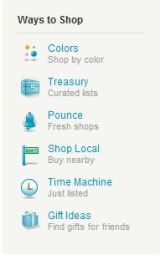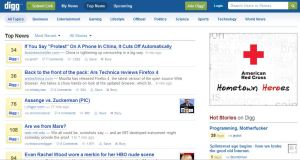‘Doing less with more’ is something we could all learn to do in many aspects of our lives, but Tim O’Reilly has built it in as  one of the main principles of Web 2.0 lightweight models and cost-effective scalability! Tim O’ Reilly states that “scalability in web 2.0 applies to business models as well as technology. Changes in cost, re-usability, process, and strategy mean much more can be done for less. Therefore, adopt a scalable, cost-effective strategy encompassing business models, development models, and technology to deliver products to market faster and cheaper without sacrificing future growth”. You have to keep your eye on the prize you know – start small, think BIG!
one of the main principles of Web 2.0 lightweight models and cost-effective scalability! Tim O’ Reilly states that “scalability in web 2.0 applies to business models as well as technology. Changes in cost, re-usability, process, and strategy mean much more can be done for less. Therefore, adopt a scalable, cost-effective strategy encompassing business models, development models, and technology to deliver products to market faster and cheaper without sacrificing future growth”. You have to keep your eye on the prize you know – start small, think BIG!
Some of the best practices for this web 2.0 principle include:
- ~Scale with demand driven by the network effect
- ~Outsource whenever practical and possible – rarely should you handle all your IT elements in house
- ~On the flip side of outsource, provide outsource infrastructure, function and expertise – capitalize on external opportunities
- ~Scale your pricing and revenue models – Don’t take a ‘one size fits all’ approach! Incorporate a multitude of revenue streams!
An example of a company that has done just this is Wikipedia! Wikipedia was founded in 2001 by Larry Sanger and Jimmy Wales as an offshoot of Nupedia, a now-abandoned project to produce a free encyclopedia. Wikipedia is an online encyclopedia that is offered for free and for the most part is written by internet authors who write without pay (sound familiar? Remember harnessing the collective intelligence ?).

a collection of quotations.
The Technical Side:
Wikipedia has obviously seen exponential growth (some would say viral growth) over the years as shown in the graph to the right. Wikipedia uses MediaWiki software, the open-source program used not only on Wikimedia projects but also on many other third-party websites. The hardware supporting the Wikimedia projects is based on several hundred servers in various hosting centers around the world. Wikimedia uses geographical DNS to distribute requests between their two main sites (US and Europe) depending on the location of the client.
In November 2008, Wikimedia announced that it would partner with Sun Microsystems to help it build a secure and scalable open Web infrastructure. According to Oracle,Wikimedia has to deal with a number of challenges such as creating an easily expandable server and storage architecture, delivering rich media content to global users, accommodating large media files up to 100 MB and scaling to service a growing number of users. Oracle assisted Wikimedia by supplementing “its existing Linux-based cluster systems with an affordable, high performance, scalable solution based on Sun Fire X4150 and Sun Fire X4250 servers. The servers run the Solaris 10 Operating System with the Solaris ZFS file system, and Sun’s MySQL database”. This has allowed Wikimedia to simplify their management system, enable easy scaling of servers and storage systems, improved data integrity with reliable backup solutions as well as enabling larger upload file sizes.
Clearly Wikimedia is doing what they can to remain scalable, but is also thinking of future growth, as stated in the 2010 Wikimedia Movement Strategic Plan Summary, Wikimedia realizes that they still do not have a technological, operational and financial infrastructure to commensurate with people’s reliance upon it. As reliance on Wikimedia grows, the technical infrastructure must also grow…
The Revenue Model:
Wikipedia is a registered trademark of the Wikimedia Foundation, Inc., a non-profit organization. The foundation is dedicated to encouraging “the growth, development and distribution of free, multilingual content, and to providing the full content of these wiki-based projects to the public free of charge”. Wikipedia has promised that the site will not display advertisements of anytime. In Wiki’s article ‘Ten things you may not know about Wikipedia’, point #1 is “We’re not for sale” – Wikipedia wants to remain a non-commercial website and is supported by donations and grants. Wikipedia has always kept it’s staff numbers low in an effort to keep overhead and costs down. There is a small number of paid staff (I counted 66…) while everyone else is a volunteer, including members on the Board of Trustees. By Wikipedia offering a free service it has allowed low barriers of adoption and cost (FREE!) to user. Wikipedia might be the only example of a site that has broken the Web 2.0 misconception that ‘having no revenue model is a viable approach’. While I would not recommend this revenue model (or lack of) for any other web 2.0 application, it has worked well for Wikimedia due to planning from day one (this free encyclopedia didn’t happen by accident).
I hope you’ve enjoyed learning a little more about Wikipedia – The question is, did you know they were non-profit?? Have you even wondered about it or just taken access to Wikipedia for granted? Imagine if one day Wikipedia could not afford to be online! GASP!!!! University students worldwide would mourn!
Related articles
- Web 2.0 and Enterprise E2.0 – in Plain English – Social Business Community Blog (aiim.org)
- WikiMedia UK Hires Full-Time Staff, Aims To Increase Content Quality On Wikipedia (thenextweb.com)
- Wikipedia’s Goal: 1 Billion Monthly Visitors by 2015 (readwriteweb.com)
- Wikipedia in Schools – WikiMedia UK AGM [Conference Presentation] (olliebray.typepad.com)













